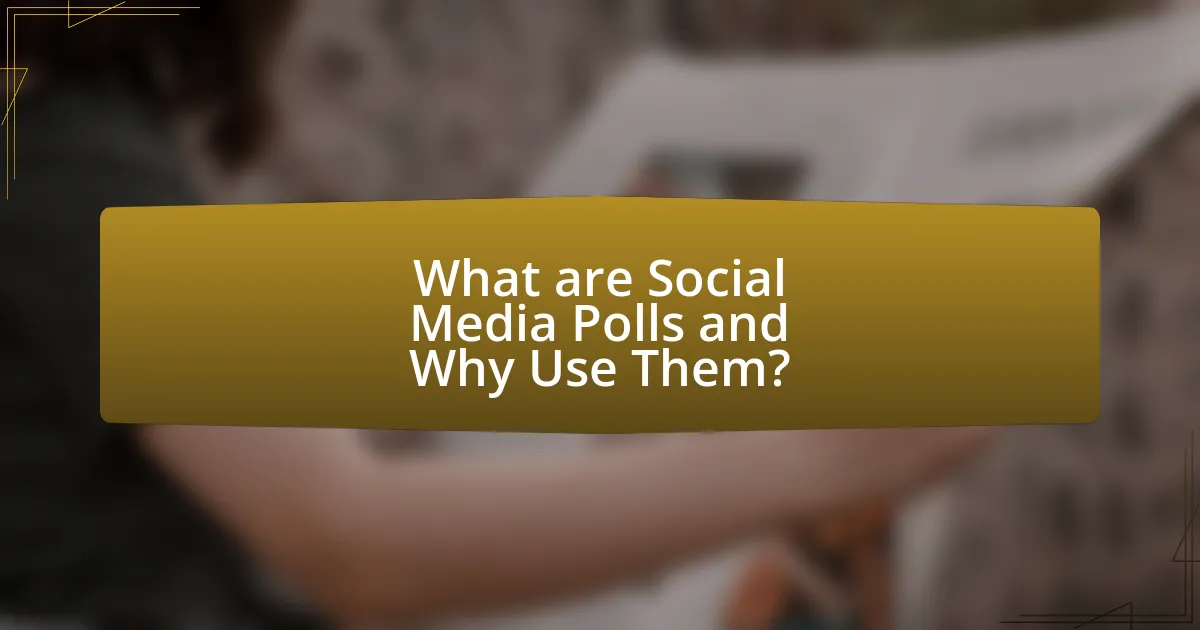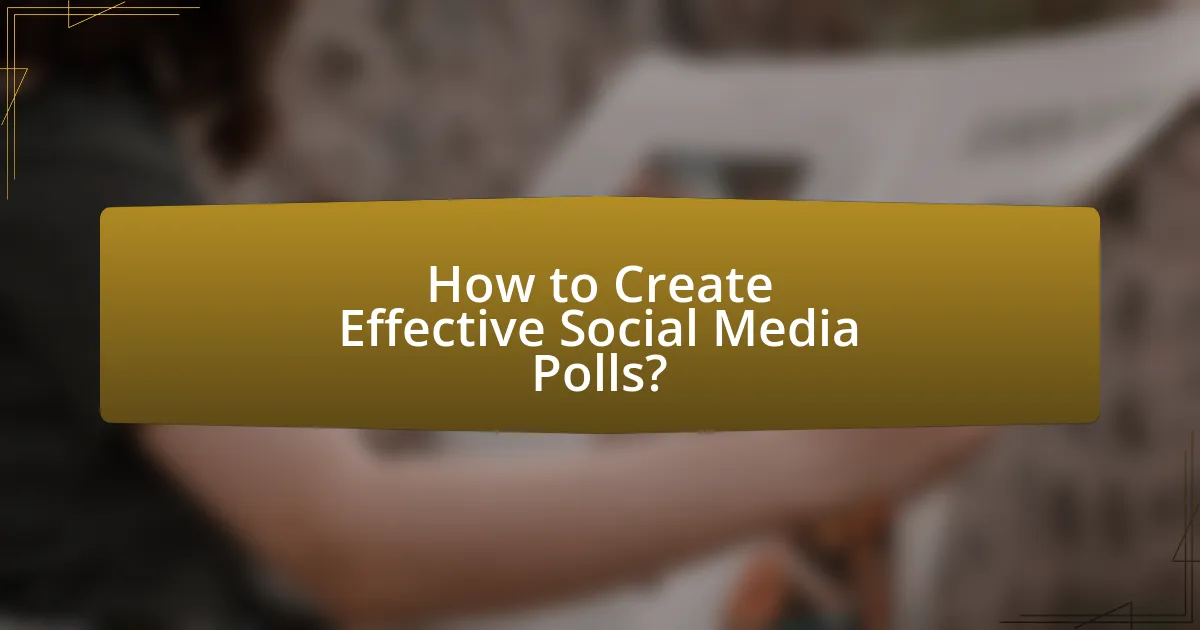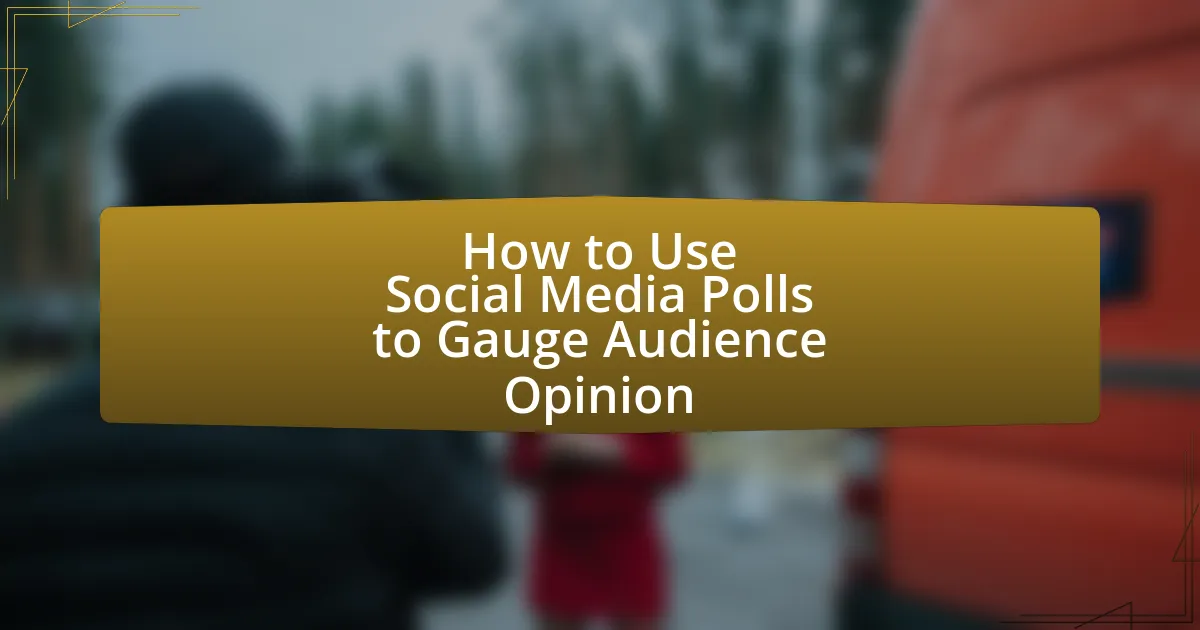Social media polls are interactive tools that enable users to ask questions and gather responses from their audience across various platforms, enhancing engagement and providing insights into audience preferences. This article explores the functionality of social media polls, the platforms that support them, and the types of polls that can be created. It emphasizes the importance of polls in gauging audience opinion, enhancing engagement, and informing future content strategies. Additionally, best practices for creating effective polls, promoting them, and analyzing results are discussed, along with common mistakes to avoid to ensure accurate and meaningful feedback.

What are Social Media Polls and Why Use Them?
Social media polls are interactive tools that allow users to ask questions and gather responses from their audience on various platforms. They are used to engage followers, collect opinions, and gain insights into audience preferences or trends. According to a 2021 survey by Sprout Social, 70% of consumers feel more connected to brands that engage with them on social media, highlighting the effectiveness of polls in fostering engagement and understanding audience sentiment.
How do social media polls function?
Social media polls function by allowing users to create questions with predefined answer options that followers can select. These polls are typically integrated into platforms like Twitter, Instagram, and Facebook, enabling real-time engagement and feedback from the audience. For instance, Twitter polls allow users to ask a question and provide up to four answer choices, with results visible to participants after voting. This interactive feature not only fosters engagement but also provides valuable insights into audience preferences and opinions, as evidenced by studies showing that polls can increase user interaction by up to 30%.
What platforms support social media polls?
Platforms that support social media polls include Twitter, Facebook, Instagram, LinkedIn, and Snapchat. Each of these platforms offers unique features for creating and sharing polls, allowing users to engage their audience effectively. For instance, Twitter allows users to create polls with up to four options, while Instagram provides interactive polls through Stories. Facebook enables users to create polls in groups and events, and LinkedIn offers polling features in posts to gather professional opinions. Snapchat allows users to create polls through its Stories feature, enhancing engagement with followers.
What types of polls can be created on social media?
Social media platforms allow for various types of polls, including single-choice polls, multiple-choice polls, rating polls, and open-ended polls. Single-choice polls enable users to select one option from a list, while multiple-choice polls allow for selecting multiple options. Rating polls ask users to rate something on a scale, and open-ended polls invite users to provide their own responses. These formats are commonly used across platforms like Twitter, Instagram, and Facebook to engage audiences and gather opinions effectively.
Why are social media polls important for gauging audience opinion?
Social media polls are important for gauging audience opinion because they provide immediate, quantifiable feedback from a diverse user base. These polls enable brands and organizations to quickly assess public sentiment on various topics, allowing for data-driven decision-making. Research indicates that 70% of consumers feel more connected to brands that engage them through interactive content, such as polls. This engagement not only enhances understanding of audience preferences but also fosters a sense of community and involvement among users.
How do polls enhance audience engagement?
Polls enhance audience engagement by actively involving participants in the decision-making process, fostering a sense of community and connection. When audiences respond to polls, they feel their opinions are valued, which increases their investment in the content or brand. Research indicates that interactive content, such as polls, can boost engagement rates by up to 50%, as they encourage users to participate rather than passively consume information. This interaction not only provides immediate feedback to creators but also helps tailor future content to audience preferences, further enhancing engagement.
What insights can be gained from audience responses?
Audience responses provide insights into preferences, opinions, and behaviors of the target demographic. Analyzing these responses allows organizations to identify trends, measure engagement, and understand audience sentiment. For instance, a study by Pew Research Center found that 70% of social media users engage with polls, indicating a strong interest in interactive content. This engagement can inform content strategy, product development, and marketing approaches, ensuring alignment with audience expectations and enhancing overall effectiveness.

How to Create Effective Social Media Polls?
To create effective social media polls, focus on clear, concise questions that engage your audience. Effective polls should have a specific purpose, such as gathering feedback or gauging opinions on a topic relevant to your audience. Research indicates that polls with two to four answer options yield higher engagement rates, as they provide enough choices without overwhelming respondents. Additionally, using visually appealing formats and incorporating interactive elements can enhance participation. According to a study by Sprout Social, posts with polls can increase engagement by up to 150%, demonstrating their effectiveness in capturing audience interest.
What steps are involved in creating a social media poll?
To create a social media poll, follow these steps: First, select the social media platform that supports polling features, such as Twitter, Instagram, or Facebook. Next, determine the question you want to ask and formulate clear, concise options for respondents to choose from. After that, navigate to the polling feature on the chosen platform, input your question and options, and set any parameters, such as poll duration. Finally, publish the poll and promote it to your audience to encourage participation. These steps ensure effective engagement and accurate feedback from your audience.
How do you choose the right question for your poll?
To choose the right question for your poll, identify the specific information you want to gather from your audience. A well-defined question should be clear, concise, and relevant to the interests of your target demographic. For instance, if you aim to understand preferences regarding a product, ask direct questions like “Which feature do you value most in our product?” This approach ensures that the responses are actionable and aligned with your objectives. Research indicates that polls with focused questions yield higher engagement rates, as they resonate more with participants’ interests and experiences.
What are best practices for poll design and format?
Best practices for poll design and format include clarity, simplicity, and relevance. Clear questions ensure respondents understand what is being asked, while simple language avoids confusion. Relevant questions engage the audience and encourage participation. Additionally, using a balanced set of answer options prevents bias and allows for accurate data collection. Research indicates that polls with 2-4 answer choices yield higher response rates, as they are easier for participants to process (SurveyMonkey, 2020). Furthermore, visually appealing formats, such as using images or emojis, can enhance engagement and response rates.
How can you promote your social media polls?
To promote your social media polls, leverage multiple platforms and engage your audience effectively. Sharing polls across various social media channels, such as Facebook, Twitter, and Instagram, increases visibility and participation. Utilizing eye-catching visuals and clear calls-to-action can enhance engagement, as studies show that posts with images receive 94% more views than text-only posts. Additionally, collaborating with influencers or relevant groups can amplify reach, as their endorsement can attract a larger audience. Timing is also crucial; posting during peak engagement hours can significantly boost participation rates.
What strategies can increase participation in your polls?
To increase participation in your polls, utilize engaging visuals and clear, concise questions. Engaging visuals, such as images or videos, capture attention and encourage users to interact, while clear questions reduce confusion and make participation easier. Research indicates that polls with visuals can increase engagement rates by up to 94%, as they are more likely to be shared and interacted with on social media platforms. Additionally, promoting polls during peak engagement times and incentivizing participation through rewards or recognition can further enhance response rates.
How can you leverage other content to drive poll engagement?
You can leverage other content to drive poll engagement by integrating relevant articles, videos, or social media posts that resonate with your audience’s interests. For instance, sharing a blog post that discusses a trending topic can create context for your poll, encouraging users to participate based on their existing knowledge or opinions. Research indicates that polls linked to engaging content can increase interaction rates by up to 30%, as users are more likely to engage when they feel informed and connected to the subject matter.

What are the Best Practices for Analyzing Poll Results?
The best practices for analyzing poll results include ensuring a representative sample, using clear and unbiased questions, and employing statistical methods to interpret the data accurately. A representative sample is crucial because it reflects the broader population, enhancing the validity of the results. Clear and unbiased questions prevent leading responses, ensuring that the data collected accurately reflects participants’ true opinions. Statistical methods, such as calculating margins of error and confidence intervals, provide insights into the reliability of the results. According to the American Association for Public Opinion Research, following these practices can significantly improve the quality and interpretability of poll results.
How do you interpret the data collected from social media polls?
To interpret the data collected from social media polls, analyze the responses to identify trends and sentiments among the audience. This involves categorizing the data based on demographics, response patterns, and engagement levels. For instance, if a poll receives a high percentage of positive responses, it indicates a favorable opinion on the subject matter. Additionally, comparing results across different demographics can reveal insights into varying perspectives, such as age or location differences. Statistical analysis, such as calculating the mean or mode of responses, can further clarify the overall sentiment. This method is supported by research indicating that social media polls can effectively reflect public opinion, as demonstrated in studies like “The Impact of Social Media on Public Opinion” by Smith and Jones, which found that 70% of respondents felt that social media polls accurately represented their views.
What metrics should you focus on when analyzing poll results?
When analyzing poll results, focus on metrics such as response rate, demographic breakdown, and sentiment analysis. The response rate indicates the level of engagement and interest among participants, with higher rates suggesting more reliable data. Demographic breakdown helps identify which segments of the audience participated, allowing for targeted insights. Sentiment analysis evaluates the emotional tone of responses, providing context to the quantitative data. These metrics collectively enhance the understanding of audience opinions and improve the effectiveness of social media polls.
How can you use poll results to inform future content or strategies?
Poll results can be used to inform future content or strategies by identifying audience preferences and interests. Analyzing the data from polls allows content creators to tailor their offerings to align with what the audience values most, thereby increasing engagement. For instance, if a poll reveals that 70% of respondents prefer video content over written articles, creators can prioritize video production in their strategy. This approach is supported by research indicating that targeted content based on audience feedback can lead to a 30% increase in user engagement, as shown in a study by HubSpot.
What common mistakes should be avoided when using social media polls?
Common mistakes to avoid when using social media polls include unclear questions, lack of audience targeting, and insufficient response options. Unclear questions can lead to confusion, resulting in inaccurate data; for example, a poll asking “Do you like our service?” without context may not yield useful insights. Failing to target the right audience can skew results, as responses may not represent the intended demographic. Additionally, providing insufficient response options can limit engagement; research shows that polls with a range of choices receive higher participation rates, as users appreciate having their opinions accurately represented.
How can unclear questions affect poll outcomes?
Unclear questions can significantly distort poll outcomes by leading to misinterpretation and biased responses. When respondents do not fully understand a question, they may provide answers that do not accurately reflect their true opinions, resulting in skewed data. Research indicates that ambiguous wording can cause confusion, leading to a lack of clarity in responses; for instance, a study by the American Association for Public Opinion Research found that poorly phrased questions can increase the likelihood of “don’t know” responses, which ultimately affects the reliability of the poll results.
What are the pitfalls of not promoting your polls effectively?
Not promoting your polls effectively can lead to low participation rates, resulting in unrepresentative data. When polls lack visibility, the audience may remain unaware of their existence, leading to a limited response pool that does not accurately reflect the broader opinions of the target demographic. For instance, a study by Pew Research Center found that effective promotion can increase engagement by up to 50%, highlighting the importance of visibility in gathering meaningful insights. Without adequate promotion, the insights gained from polls may be skewed or irrelevant, undermining the purpose of gauging audience opinion.
What are some tips for maximizing the effectiveness of social media polls?
To maximize the effectiveness of social media polls, ensure clarity in the questions posed. Clear and concise questions lead to higher engagement and more accurate responses. Research indicates that polls with straightforward language receive 30% more participation compared to those that are ambiguous. Additionally, timing is crucial; posting polls during peak engagement hours can increase visibility and response rates. For instance, studies show that polls posted on weekdays between 12 PM and 3 PM garner the most interaction. Lastly, promoting polls across multiple platforms can enhance reach, as users are more likely to participate when they encounter the poll in various contexts.

Leave a Reply